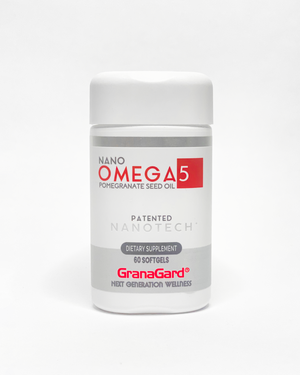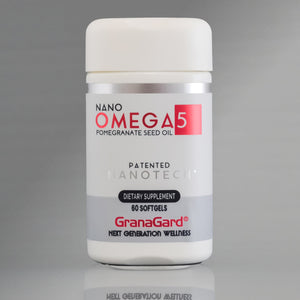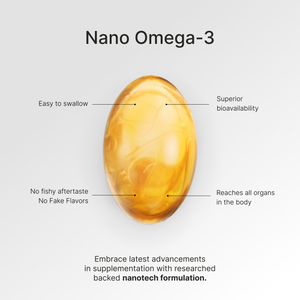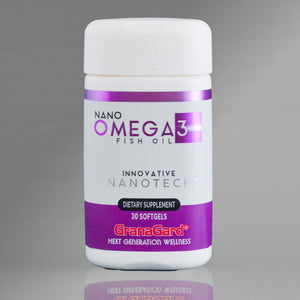Omega 3 is widely known for its benefits on cardiometabolic health, but recent studies have shown that it can play a crucial role in anti-aging strategies.
Normal Aging
What Happens in Our Cells
Our body is made up of more than 30 trillion cells, and in each one, we will find three main components: the cell membrane, the nucleus, and the cytoplasm. The other structures within them are primarily adapted to their specialized functions: muscle cells, nerve cells, digestive tract cells…
From birth, our body grew until reaching adulthood, and during that period, it also had to renew cells, not all at the same speed, as some live for years while others only days.
The fact is that for both processes, growth and repair, cells must divide. This division involves the generation of two identical daughter cells with similar genetic information.
The Importance of Chromosomes
Within the nucleus of each of our cells are the chromosomes, the structures that house DNA in the cell. Chromosomes are structurally very sophisticated, containing the elements necessary for cell division. Each species has a characteristic set of chromosomes; for example, humans have 46 chromosomes.
In the late 20th century, structures called Telomeres were described at the ends of chromosomes. They are regions made up of non-coding DNA, meaning they do not contain information necessary for protein synthesis. The codes within these regions are highly repetitive, and their primary function is the structural stability of chromosomes. Telomeres act as protective shields for cellular DNA, similar to the protectors that cover the ends of shoelaces. In turn, the integrity of Telomeres depends on an enzyme called Telomerase, which was discovered later.

Why We Age
The continuous process of cell division necessary for tissue and organ repair affects the length of Telomeres, which shorten with each new division. Eventually, they become so short that they can no longer participate in a new division, meaning that cell will no longer multiply or contribute to tissue regeneration, as it has reached its "old age" state. This is why Telomere length is considered a key molecular "biomarker of aging."
Telomerase deficiency and the presence of abnormally short Telomeres induce the premature loss of tissue regenerative capacity, which of course, will lead to the onset of age-related diseases. Studies conducted on Leukocytes (white blood cells) have shown that Telomere length significantly shortens from birth to old age. Measured in kbp (the unit of measurement for nucleic acids in pairs as they form DNA; 1 kbp equals the length of 1,000 nucleic acids lined up), from 11kbp at birth to 4kbp in old age.
Cell divisions are not the only factor affecting Telomere shortening; others, such as diet (What are the best antioxidant foods) and oxidative stress (Oxidative Stress: Myth or Reality) also play a role.
These discoveries and research have been so significant in understanding the aging process that in October 2009, Elizabeth H. Blackburn, Carol W. Greider, and Jack W. Szostak were awarded the Nobel Prize in Physiology and Medicine for their discoveries on Telomeres and the enzyme Telomerase.
Omega 3 Against Aging
Results from multiple studies have demonstrated the beneficial effects of omega-3 fatty acids on Telomere length. This occurs through a triple mechanism of action: on the one hand, it has been shown that oxidative stress and inflammation are strongly associated with Telomere shortening and accelerated dysfunction, and the effects of Omega 3 (10 Omega 3 body systems organs benefits) in reducing the damage caused by oxidative stress (Oxidative Stress: Myth or Reality) and inflammation are well-documented.
On the other hand, the direct action of Omega 3 (10 Omega 3 body systems organs benefits) on the enzyme Telomerase has also been studied, making it more effective. In simple terms, Omega 3 counteracts the action of factors that directly damage Telomeres, but it also enhances the action of the enzyme responsible for restoring them, Telomerase.

The NEW GENERATION of Omega 3
The use of omega-3 fatty acids to reduce the accelerated wear of Telomeres, and consequently, counteract premature aging and the risk of age-related diseases, raised great hopes.
Like all fatty acids, Omega 3 is lipophilic, meaning it dissolves very well in a fatty environment but not in water. Try it yourself: try to dissolve the contents of a soft capsule of any Omega 3 in water, and you'll see that it's impossible.
As we saw earlier, cells have different compartments and structures; some are fatty (lipid) content, and others are hydrophilic (aqueous) content, so the proper dissolution and distribution of a substance between these compartments would be determined by its lipophilic or hydrophilic nature.
The extraordinary news that will make the hope raised by Omega 3 as an anti-aging agent possible is its transformation through nanotechnology (What is Nanotechnology) of Omega 3 into a nanoemulsion, that is: an Omega 3 that can dissolve in water and oil, is hydrophilic and lipophilic, reaching all cellular compartments in all organs. This nanoformulation allows it to achieve 4 times the absorption and potency of conventional Omega 3. For this reason, it is considered the new generation of Omega 3.
Now you can help your body stay young longer. Start today with Nano Omega 3 from GranaGard®!





